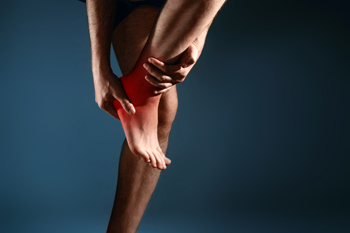 Research has indicated there are several different forms of ankle pain. Many people will experience some type of ankle pain throughout their lives, and this may come from a variety of reasons. These may include medical conditions such as arthritis, or from an injury. Ankle sprains are considered to be one of the most common forms of ankle pain, and this typically occurs when the ligaments in the ankle and surrounding areas are overstretched. This may happen as a result of tripping or falling, which may cause the ankle to roll inward toward the ground. Other reasons patients may have ankle pain may include infections in the joints of the ankle, nerve damage, or blood vessels that may be blocked. When ankle pain is first noticed, it’s important to rest the foot by taking the weight off of it. If it appears swollen, elevation may bring a mild form of relief. Please consult with a podiatrist who can properly guide you toward feeling better.
Research has indicated there are several different forms of ankle pain. Many people will experience some type of ankle pain throughout their lives, and this may come from a variety of reasons. These may include medical conditions such as arthritis, or from an injury. Ankle sprains are considered to be one of the most common forms of ankle pain, and this typically occurs when the ligaments in the ankle and surrounding areas are overstretched. This may happen as a result of tripping or falling, which may cause the ankle to roll inward toward the ground. Other reasons patients may have ankle pain may include infections in the joints of the ankle, nerve damage, or blood vessels that may be blocked. When ankle pain is first noticed, it’s important to rest the foot by taking the weight off of it. If it appears swollen, elevation may bring a mild form of relief. Please consult with a podiatrist who can properly guide you toward feeling better.
Ankle pain can be caused by a number of problems and may be potentially serious. If you have ankle pain, consult with Dr. Mark Gagnon from Advanced Podiatry. Our doctor will assess your condition and provide you with quality foot and ankle treatment.
Ankle pain is any condition that causes pain in the ankle. Due to the fact that the ankle consists of tendons, muscles, bones, and ligaments, ankle pain can come from a number of different conditions.
Causes
The most common causes of ankle pain include:
- Types of arthritis (rheumatoid, osteoarthritis, and gout)
- Ankle sprains
- Broken ankles
- Achilles tendinitis
- Achilles tendon rupture
- Stress fractures
- Bursitis
- Tarsal tunnel syndrome
- Plantar fasciitis
Symptoms
Symptoms of ankle injury vary based upon the condition. Pain may include general pain and discomfort, swelling, aching, redness, bruising, burning or stabbing sensations, and/or loss of sensation.
Diagnosis
Due to the wide variety of potential causes of ankle pain, podiatrists will utilize a number of different methods to properly diagnose ankle pain. This can include asking for personal and family medical histories and of any recent injuries. Further diagnosis may include sensation tests, a physical examination, and potentially x-rays or other imaging tests.
Treatment
Just as the range of causes varies widely, so do treatments. Some more common treatments are rest, ice packs, keeping pressure off the foot, orthotics and braces, medication for inflammation and pain, and surgery.
If you have any questions, please feel free to contact one of our offices located in Crestwood, Orland Park, and Summit, IL . We offer the newest diagnostic and treatment technologies for all your foot care needs.
